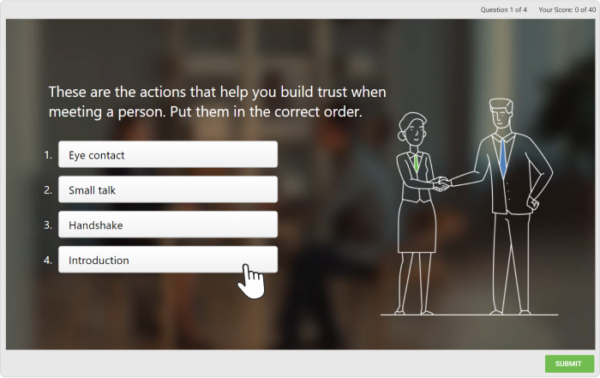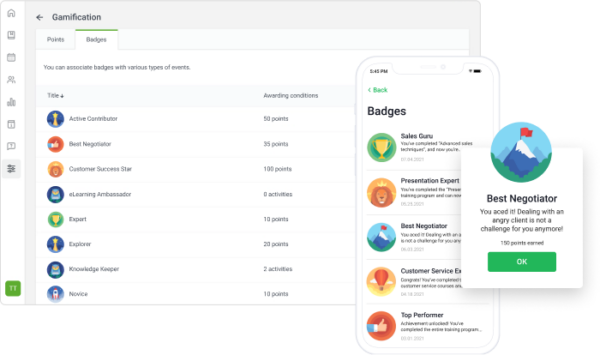Companies have a lot at stake in keeping their employees motivated and engaged because this is what drives teams forward. There are various ways to motivate employees, and properly organized corporate training is one of them.
In this article, we’ll show how you can use online training to improve the motivation and engagement of your team company wide. Check out these seven tips to impel your employees to do their best in training and work.
1. Make training relevant
First things first: make sure your online training program has practical applications to job requirements. Corporate training aims to change the way employees perform and should reflect on their daily operations in a positive way.
However, when training employees, you deal with adults who have numerous responsibilities and always lack time. It’s typical for them to have “What’s in it for me” moments when facing something new. So, your task is to show the practical value of a new training program in advance. When employees see that training is relevant for them and may help with their work, they are more eager to study.
2. Expect tangible results
Let’s illustrate this point with a simple example. Imagine you have a sales team and prepare a training program for them. Would you choose some abstract goals to encourage their participation? Would you expect them to just take a course that yields no result? Guess not. Training will make sense if you motivate the sales team to meet certain quotas or increase sales by a certain percentage.
The point is to make employees aware of these training goals. If they understand the direct link between sales success and training, employees will have more interest in participating in the process.
3. Add interactivity
Your slide-based courses will be much more engaging if you add interactive elements: navigation buttons, triggered animations, hotspots, drag-and-drop exercises, and more. Use specific authoring tools – software that allows building interactive learning content like quizzes and minigames from scratch or use pre-existing materials.
Employees can interact with such learning content using their touchscreen or a mouse and see it as lively and inspiring. This will be fun and will help learners acquire and retain knowledge better.

Some authoring tools enable you to make colorful interactive dialogue simulations that will be extremely helpful for customer service and sales training. Dialogue simulations serve as a safe-to-fail digital environment in which your employees can practice their knowledge. For example, they can train their communication and decision-making skills by interacting with a virtual customer and choosing the best response.

4. Keep it short
Given the choice, most employees will prefer bite-sized courses to hour-long lectures. Delivering training content in shorter, one step at a time pieces, is called microlearning. It presupposes that learning materials address a single question or learning objective and keep learners focused on it.
Microlearning is especially good if your employees complete training on their mobile devices. This will enable them to fit microcourses into any timetable and take them ‘on the go.’ As such, employees maintain their motivation to study longer and have a sense of accomplishment in the learning tasks.
Here is how you can wrap a customer journey map into a five-paged minicourse.

5. Give learners control
eLearning is wonderful because it enables us to learn at one’s own pace and in the location of choice. When employees control the time and place of their learning, they can take online courses or watch training videos while calm, focused, and with a minimum of distractions.
Also, you can offer additional courses or other helpful materials so that your team members can choose something for self-study. This is important because when employees can decide for themselves what else they want to learn, they feel more engaged. This way, they’ll embrace training quicker and lay out their own learning paths. The more they become engaged, the more it feels natural for them to take training.
6. Provide feedback
To keep your employees motivated, ensure that they receive support along the way. In eLearning, it is especially important to maintain human contact, even if there is no instructor or supervisor present. By providing timely feedback on training efforts, you comfort the learners and encourage them to continue the process.
So, it will be nice to put encouraging notes at the end of the quiz. Or you can offer some careful explanation after each incorrect question attempt like this:

7. Recognize and award
You can boost employee engagement with some game elements. That’s right, ‘serious’ work and corporate training can adopt reward systems from ‘kid’s’ games. For example, employees can gain points and collect badges when they accomplish every new course. If you use a learning management system (LMS) to upload learning materials and track employees’ results, it may have such gamification features. Most LMSs can award points and badges automatically.
Such game elements make employees develop their skills but let them feel like they’re completing a level in a video game. You also can publish leaderboards of the best learners each month. Social recognition and healthy competition, when everyone’s success is validated, will encourage employees and motivate them toward new achievements.

Conclusion
Nowadays, more and more companies opt for online training for their employees. It’s a faster, cheaper, and more convenient way to create learning content and deliver it to employees. However, like any process in your company, it’s as effective as your employees put their efforts into it.
Using these seven practices, you can motivate them to achieve better performance in learning, embrace opportunities for self-development, and become more committed to practicing new knowledge in the workplace. We hope you find these tips helpful!
Business & Finance Articles on Business 2 Community
(84)
Report Post






